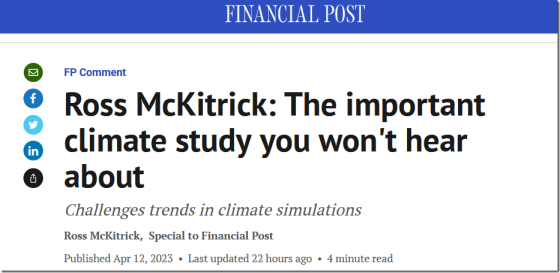by R. Cutler, May 25, 2023 in ClimateChangeDispatch
Global warming completely stopped in 2018. Temperatures will likely remain steady until 2025 and may decline slightly by 2030.
A strong El Niño in 2023 is unlikely.
I’ll explain all of my predictions — after we hear from the experts. [emphasis, links added]
NOAA recently predicted a 55% chance of a strong El Niñoin late 2023.
The World Meteorological Organization (WMO) threw more fuel on the fire when it announced, “There is a 98% likelihood that at least one of the next five years, and the five-year period as a whole, will be the warmest on record.”
Obviously, the MSM had a field day with this. Take for example this headline from USA Today: “Scientists warn an El Niño is likely coming that could bring scorching heat to Earth.”
Rather than taking the well-worn path of pointing out flaws in the predictions of NOAA, the IPCC, or the WMO, I’ll instead show how the sun is likely responsible for almost every detail in global temperaturesover the last 125 years, and that it is also responsible for triggering strong El Niños.
Two empirical, or black-box models were created to predict global temperature. The first model uses solar magnetic field data from the Wilcox Solar Observatory (WSO).
The second model uses sunspot data from WDC-SILSO, the Royal Observatory of Belgium, Brussels. Both predictions will be compared to global temperature anomaly data from NOAA.
Solar magnetic field data collection began in 1976. The complete WSO dataset can be viewed in a single graphic, often referred to as a butterfly diagram.
It looks complicated, but it’s really not. It’s just a plot of solar magnetic field intensity over time as a function of the sun’s latitude. The two colors represent north and south polarity magnetism.
Unlike the Earth, where magnetic north has conveniently stayed in the Northern Hemisphere for the last 780,000 years, the sun’s magnetic field changes polarity every 11 years.




